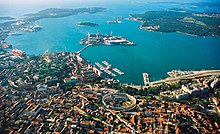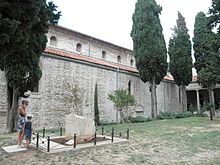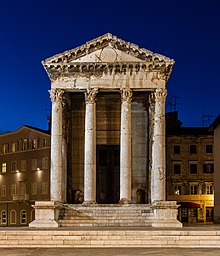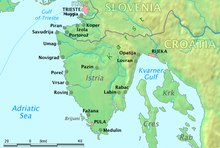Pula
This is the sighted version that was tagged on May 29, 2021. There is 1 pending change that needs to be sighted.
![]()
The title of this article is ambiguous. For other meanings, see Pula (disambiguation).
Pula [ˈpuːla] (German and Italian Pola; Slovenian Pulj; Ancient Greek Πόλαι Pólai; Latin Colonia Pietas Iulia Pola Pollentia Herculanea) is the largest city in Istria County in Croatia, with 57,460 inhabitants as of 2011. Pula is located near the southern tip of the Istrian peninsula and belongs to the Catholic Diocese of Poreč-Pula.
History
Ancient
Prehistoric pottery from the Neolithic period (6000-2000 BC) has been found in the vicinity of Pula, indicating early settlement. The first settlement of the city by the Illyrian tribe of the Histri is dated to the 10th century BC.
Conquered by Romans in 177 BC, Pula became a Roman colony under the name Colonia Pietas Iulia Pola. Under Emperor Augustus, the amphitheatre was built, which is now one of the main sights of the city. In addition to the amphitheatre, from the Augustan period there is the Temple of Roma and Augustus, the city wall with gates, preserved in parts, and the remains of two theatres.
In the 4th century AD, a naval base of the Venetian fleet (classis Venetum) was established there to protect the Adriatic coastal waters.
During the collapse of the Western Roman Empire in the 5th century, Pula came under the rule of the Ostrogoths. Emperor Justinian was able to conquer Pula for the Eastern Roman Empire in the 6th century; the city was developed into a naval base for the Byzantines.
In the second half of the 6th century, the Slavs advanced into Istria. However, they were unable to take the Istrian coastal towns, including Pula. There, the urban culture of the long-established Romans continued without interruption.
While the Istrian hinterland had been part of the Frankish Empire and later the Holy Roman Empire since the end of the 8th century, Pula remained nominally part of the Byzantine Empire but was de facto independent.

enlarge and show information about the picture
![]()
Roman amphitheatre from the inside
Venetian domination
With the decline of Byzantine power, Pula had to look for new allies. The Byzantine emperor was replaced by the Republic of Venice at the end of the 11th century. In 1150, Pola signed a treaty with the city on the lagoon, by which the city submitted to Venetian rule. Since then, it paid tribute, participated in the construction and equipping of galleys for the Venetian fleet and sent troops when the Republic of St. Mark waged war.
The Counts of Gorizia exercised considerable influence in the 13th century and appointed the vicarius in Istria. The Sergi family succeeded in gaining the support of the Patriarch of Aquileia, in addition to the Gorizians, and thus established an almost independent dominion from about 1294, which lasted until 1319. In 1331 the council of the town offered submission to Venice, and in 1335, to prevent a return of the Sergi, the inhabitants destroyed the fort and the tower above the town. Later, a Venetian nobleman was placed at the head of the city administration. Until the end of the Republic of Venice in 1797, Pula remained part of this state system, after which it became part of the Habsburg dominion, since 1804 called the Austrian Empire.
Austrian rule
After the revolution of 1848, Venice was no longer viable as a main war port for the Austrian navy; the crews of the ships in the arsenal had almost all joined the rebellion directed against Austria. The choice was between developing Trieste, which already had an efficient commercial port, or the small fishing town of Pola, which at the time had only about 900 inhabitants but an almost perfect natural harbour. Naval commander Hans Birch Dahlerup initially favoured Trieste because of the existing infrastructure, but was soon convinced of the advantages of a completely new start in Pola, which was also much easier to defend.
Emperor Franz Joseph I knew Pola Bay from a visit in 1845 (while still Archduke) and visited it again in 1850; he may have personally played an important role in the decision in favour of Pola. In 1851 the Pola Municipal Council ceded four large plots of land to the military free of charge for the construction of a new naval arsenal. In 1852, for the first time, comprehensive plans for the development into the main Austrian military port were available.
On 9 December 1856, Emperor Franz Joseph I officially laid the foundation stone for the construction of the Seaside Arsenal; he was accompanied by his wife Elisabeth and his brother, the naval commander Archduke Ferdinand Max, who was promoted to Vice-Admiral by the Emperor here. Construction of the naval arsenal was well advanced by this time. (The Uljanik shipyard in Pula still refers to the official founding date of 9 December 1856).
In the following years Pula experienced a boom, which was almost exclusively due to its development into the main Austrian war port: the population of the town grew from 900 in 1848 to 6551 in 1857, to 25,179 in 1881 and finally to 58,560 at the last census under Austrian rule in 1910. All major buildings (shipyard, naval barracks, engine school, naval hospital, naval garrison church, naval casino, hydrographic office with observatory, infantry barracks, railway station, social housing, civilian schools, hotels, etc.) were directly connected with the expansion to the imperial and royal capital. They still characterize the entire cityscape today. In astronomy, Pula is known for Johann Palisa, who discovered the first 29 of his 123 asteroids at the local naval observatory from 1874 to 1880.
In Meyers Konversations-Lexikon one and a half printed pages were dedicated to the city in 1896: Pola was described as a fortress of the first rank; on the hills above the city there were 28 forts, partly with armoured towers. Between the island of Brioni / Brijuni and the mainland was the outer harbour; the actual harbour was 8.6 km² in size, part commercial, part war harbour. The naval section of the k. u. k. War Ministry operated in Pola from dry and floating docks to the Naval Academy, the Hydrographic Office, an artillery laboratory and a powder magazine to the arsenal (with 2000 workers) all facilities important for naval warfare. Together with the submarines of the monarchy, the submarines of the U-flotilla Mediterranean of the German Imperial Navy were also stationed here during the First World War. Still today the "K. u. k. Naval Cemetery" on Ulica Stoja (Via Stoia) and the facilities in the bay next to it are still reminders of this time.
Around 1912, the first large radio telegraph station - Radiopola - was built in the k. u. k. war port of Pola, a first large radio telegraph station - Radiopola - with a long range to the Atlantic and the Red Sea.
Since the First World War
When the new South Slavic state was formed at the end of the First World War on October 29, 1918, and Austria-Hungary lost its access to the sea as a result, Emperor Karl I ordered on October 30 that the Imperial and Royal Navy be handed over to the South Slavs. Kriegsflotte to the South Slavs. On October 31, 1918, Rear Admiral Horthy carried out the surrender in Pola in accordance with his orders: The k. u. k. The Austro-Hungarian flag was lowered, the South Slav flag was raised, and South Slav naval officers took command.
Nevertheless, the battleship Viribus Unitis, now called Jugoslavia and still the pride of the fleet, was sunk at 6 a.m. on 1 November 1918 by two Italian combat swimmers who had distributed and detonated explosive charges on the hull by means of a converted torpedo. Over 400 sailors died, including the ship's last commander, Janko Vuković-Podkapelski; a memorial plaque was erected in Pola to honour him and the other fallen.
After the armistice of 3 November 1918, Pola was occupied until 9 November by Italian troops, who also took over the fleet. By the Treaty of Saint-Germain and other peace treaties in 1919, it became part of Italy, as did the whole of Istria.
At the end of the SecondWorld War, the city was taken by Yugoslavian troops in May 1945, but they had to leave it again by 12 June 1945 at the latest. On 9 June 1945, the USA, Great Britain and Yugoslavia agreed on this and that the city, like the area of and around Trieste, would then be jointly administered by the war victors. Pula formed an exclave of (Italian) Zone A in (Yugoslavian) Zone B.
In 1947, however, the city was not incorporated into the Free Territory of Trieste, which was constituted as a separate state, but, as stipulated in the Italian-Yugoslav part of the Paris Peace Treaty of 1947, was annexed to the Yugoslav constituent republic of Croatia.
A large part of the Italian population, about 30,000 out of 34,000, was then expelled.
The Vergarola massacre contributed to this. On 18 August 1946, near the beach in the bay of Vergarola near Pola, during the festival of an Italian sports club, mines stored in a pine forest, already defused, exploded with nine tons of explosives. The explosion was blamed on the Yugoslav secret service OZNA and officially claimed 65 lives, but probably many more.
Like all of Croatia, Pula was part of Yugoslavia until 1991. The island of Brioni (as it was quoted in foreign media) or Brijuni, off the coast of Pula, gained international fame because the Yugoslav head of state Marshal Tito set up his summer residence there, where he was visited by statesmen from all over the world. Moreover, the Brijuni Agreement was concluded on the islands in 1991, which ended the 10-day war in Slovenia.

Bronze model of Pula

Aerial view of Pula

Monument to the memory of the Vergarola massacre in 1946 near Pula Cathedral

Historical map of the surrounding area, around 1888

Augustus temple in Pula

Location of Pula on the southern tip of Istria
Population
The town had about 1100 inhabitants in 1851, about 25,000 in 1880 and almost 39,000 in 1890, including 5900 military personnel. According to the imperial and royal census of 1900, 40,641 people lived in Pula, including the garrison, of whom 24,056 were Italians (59%), 10,388 Croats (26%), 4,654 Germans (11%) and 1,543 Slovenes (4%).
According to the 2011 census, Croats are the overwhelming majority of the population, accounting for 70.14% of the population. 29.86% belong to other ethnic groups, of which Serbs with 6.01% and Italians with 4.43% are the two largest in Pula. Slovenes, Bosniaks, Albanians, Hungarians, Germans, Sinti and Roma also live in Pula. The Jewish community today counts 30 to 50 members.
The city of Pula is officially bilingual. Besides Croatian, Italian is the second official language. In the hinterland, the Istrian language is spoken, the oldest language in Istria.
Search within the encyclopedia